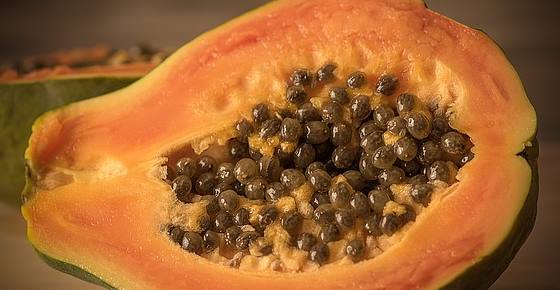
Papaya is a delicious fruit that has many health benefits because it is full of antioxidants, vitamins and minerals. Eating papaya fruit can help to strengthen your immune system and improve your digestive health. It can also help improve your eyesight, lower cholesterol levels, and give a boost to your skin’s health. Papaya fruit is also a good source of vitamins such a vitamin C, E, and A.
Apart from consuming papaya, extracts from papaya fruit, leaves and seeds can also boost your health. Papaya extracts are also full of vitamins and have been linked to managing diabetes and they may also have anticancer properties.
In this article, I will look at scientific research into the health benefits of the papaya fruit and seeds.
What Is Papaya (Pawpaw)?
Papaya (Carica papaya) is a large pear shaped fruit that grows in tropical climates. In some countries, papaya is also called pawpaw or papaw.
Papaya is a fleshy fruit with soft pulp and it has different colors that vary from yellow to red.
Papaya fruit is usually a bright orange color and ripe papaya tastes like sweet melon. A ripe papaya has a slightly sweet smell. If the papaya doesn’t have scent, it’s not ripe yet, however if it has a strong sweet smell, it’s overripe.
You can also eat papaya seeds. The black seeds from the papaya are in a gelatinous substance in the middle of the fruits. Papaya seeds have a peppery, sometimes bitter, taste to them.
There are many ways that you can consume papaya or pawpaw. You can eat papaya fruit raw, extract juice from papaya, or use papaya seeds in salads or delicious smoothies. You know when papaya fruit is ready to eat when it feels slightly soft and the skin has a reddish-orange look.
Papaya Nutrition Facts
Papaya is a fruit that is rich in vitamin C and because of that, it is a healthy addition to your diet. In fact, one cup of mashed papaya fruit (140 g) contains over 230% of your recommended daily intake (RDI) of vitamin C! (1)
The high content of vitamin A in papaya fruit can help to offset vitamin A deficiencies.
Vitamin A and vitamin C are both powerful antioxidants, so the ‘fruit of the angels’, as Christopher Columbus called it, destroys free radicals in the body – the villains behind many chronic diseases, including cancer and cardiovascular disease.
There are 43 calories in 100 g of papaya. One small papaya (weighing 157 g) has 68 calories. One big papaya (weighing 781 g) has 336 calories. (2)
Papaya also contains many vitamins and minerals that make it a very healthy fruit. The U.S. Department of Agriculture says that 100 g of papaya contains the following: (2)
- 60 mg vitamin C
- 950 IU vitamin A (22% RDI)
- 37 mcg folate (10% RDI)
- 24 mg calcium
- 257 mg potassium
- 10 mg magnesium
- 25 mg omega-3 fatty acids
- 7 g dietary fiber (7% RDI)
Papaya fruit and extracts also contain important compounds that have medicinal benefits. For example, papaya contains a compound called papain which has been linked to digestive health and it also has anticancer properties.
READ MORE HERE:
~~~~~~~~~~~~~~~~~~~~~~~~~~~~~~~~~~~~~~~~~~~~
8 Evidence-Based Health Benefits of Papaya
The papaya is an incredibly healthy tropical fruit.
It's loaded with antioxidants that can reduce inflammation, fight disease and help keep you looking young.
Here are 8 health benefits of papaya.

Papaya is the fruit of the Carica papaya plant.
It originated in Central America and Southern Mexico but is now grown in many other parts of the world. Papaya contains an enzyme called papain, which can break down the tough protein chains found in muscle meat. Because of this, people have used papaya to tenderize meat for thousands of years.
If the papaya is ripe, it can be eaten raw. However, unripe papaya should always be cooked before eating — especially during pregnancy, as the unripe fruit is high in latex, which can stimulate contractions.
Papayas are shaped similar to pears and can be up to 20 inches (51 cm) long. The skin is green when unripe and orange when ripe, while the flesh is yellow, orange or red. The fruit also has many black seeds, which are edible but bitter.
It originated in Central America and Southern Mexico but is now grown in many other parts of the world. Papaya contains an enzyme called papain, which can break down the tough protein chains found in muscle meat. Because of this, people have used papaya to tenderize meat for thousands of years.
If the papaya is ripe, it can be eaten raw. However, unripe papaya should always be cooked before eating — especially during pregnancy, as the unripe fruit is high in latex, which can stimulate contractions.
Papayas are shaped similar to pears and can be up to 20 inches (51 cm) long. The skin is green when unripe and orange when ripe, while the flesh is yellow, orange or red. The fruit also has many black seeds, which are edible but bitter.
One small papaya (152 grams) contains (2):
- Calories: 59
- Carbohydrates: 15 grams
- Fiber: 3 grams
- Protein: 1 gram
- Vitamin C: 157% of the RDI
- Vitamin A: 33% of the RDI
- Folate (vitamin B9): 14% of the RDI
- Potassium: 11% of the RDI
- Trace amounts of calcium, magnesium and vitamins B1, B3, B5, E and K.
Papayas also contain healthy antioxidants known as carotenoids — particularly one type called lycopene.
What's more, your body absorbs these beneficial antioxidants better from papayas than other fruits and vegetables
READ MORE HERE:
//////

Wow, thats surely exquisite to recognize the fact and I am positive you will also love my article written here apple nutrition facts approximately Hope so you will love to provide me a go-to.
ReplyDelete